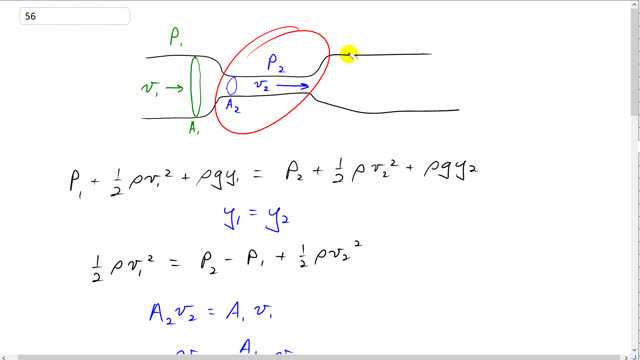
- Show that the flow speed measured by a venturi meter (see Fig. 10–29) is given by the relation .
- A venturi meter is measuring the flow of water; it has a main diameter of 3.5 cm tapering down to a throat diameter of 1.0 cm. If the pressure difference is measured to be 18 mm-Hg, what is the speed of the water entering the venturi throat?
- see video

In order to watch this solution you need to have a subscription.
This is Giancoli Answers with Mr. Dychko. Here's a Venturi tube where we want to figure out what the speed of the fluid is in this section and we do that by having this constriction applied here and measure the pressure here and compare that to the pressure in the first section and knowing the cross-sectional areas of these two sections of cylindrical pipe, we can apply Bernoulli's equation and the equation of continuity and figure out what the speed is in the section of pipe here. So Bernoulli's equation first says that the pressure in the first section of pipe plus one-half density of the fluid times the speed there squared plus ρg times vertical position, y 1, equals pressure in the second section of pipe plus one-half density times v 2 squared plus its vertical position times ρ times g but these terms here don't matter because y 1 equals y 2... there's no change in height here. And then we can take this P 1 to the right hand side so that makes it minus P 1 and then plus one-half ρv 2 squared and we have one-half ρv 1 squared left over on the left. And we need to express v 2 in terms of v 1 so that we have only one variable in our equation so we look at the equation of continuity which says that the volume rate of flow the number of cubic meters per second in each section of the pipe has to be the same otherwise there'd have to be some mass building up somewhere and that's not gonna happen because the fluid is incompressible. So A 2v 2 equals A 1v 1 and we divide both sides by A 2 and you get v 2 is A 1 over A 2 times v 1 so we can substitute that in for v 2 here and otherwise, I just copied this equation. And then we'll take this term back to the left side because now it has a v 1 in it and we want to collect all the v 1 terms together and so we have one-half ρv 1 squared minus one-half ρA 1 squared over A 2 squared times v 1 squared equals P 2 minus P 1. And the next step is to multiply everything by A 2 squared and then also multiply everything by 2 and divide everything by ρ and so the one-half and the ρ from this term will disappear and we'll have only an A 2 squared multiplied by it. And in this term here, we'll have just A 1 squared times v 1 squared A 2 squared's will cancel when multiplying by this and the ρ will cancel and the one-half will cancel with the 2 and here we have, well, we'll just write 2 times A 2 squared over ρ multiplied by this difference P 2 minus P 1. Then factor out the v 1 squared from both these terms so we have v 1 squared times A 2 minus A 1 squared equals this right hand side copied and then the textbook formula has the P 1 coming first so P 1 minus P 2 and it has the A 1 squared coming before the A 2 squared so we can make that happen multiply both sides by negative 1 and then that changes the sign of every term. So the A 2 becomes negative and the A 1 becomes positive and likewise the P 2 becomes negative and the P 1 becomes positive and so there we have that and then we can divide both sides by this bracket and then take the square root of both sides at the same time and the A 2 squared comes out of the square root and becomes just A 2— any perfect square factor can go outside the radical and be square rooted. So we have A 2 multiplied by square root of 2 times P 1 minus P 2 and divided by ρ times A 1 squared minus A 2 squared... there we have it! And then we apply it to this particular question so we have π times the constrict diameter of 1 centimeter expressed in meters so 1 times 10 to the minus 2 meters, divide that by 2 to get the radius and square that to get the area of the constricted section of the Venturi tube times by square root of 2 times 18 millimeters mercury times 133 pascals for every millimeter of mercury and divide that by 1.0 times 10 to the 3 kilograms per cubic meter—density of water— times the A 1 squared which would be π squared times radius to the power of 4 so that's 3.5 times 10 to the minus 2 meters over 2 to the power of 4 minus π squared times 1.0 times 10 to the minus 2 over 2 to the power of 4 and here's how it looks in a calculator and whatever I'm showing you, this calculator stuff, I'm trying to... when I'm showing the work on the white board here, I'm trying to show absolutely everything whereas on the calculator, I'm trying to be efficient and show you as few keystrokes as possible to plug in all this stuff. So here we have 0.18 meters per second is our speed in the first section of the tube.